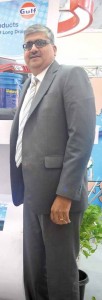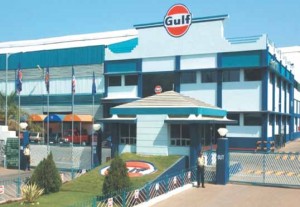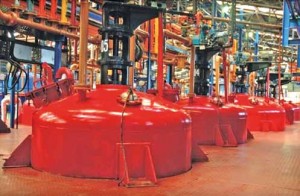By R. Natarajan, Managing Editor & Publisher
 Whilst the overall economic scenario of India is facing a downtrend, the Lubricants Division of Gulf Oil Corporation Ltd. is expected to witness strong growth in the coming year. The robust growth in this division has been mainly on account of aggressive brand building exercises, channel expansion and introduction of new products for the diesel engine and motorcycle segments. The aggressive stance taken by the division has helped its aftermarket segment grow to nearly two to three times more than the industry average besides entering into many new tie-ups with OEMs.
Whilst the overall economic scenario of India is facing a downtrend, the Lubricants Division of Gulf Oil Corporation Ltd. is expected to witness strong growth in the coming year. The robust growth in this division has been mainly on account of aggressive brand building exercises, channel expansion and introduction of new products for the diesel engine and motorcycle segments. The aggressive stance taken by the division has helped its aftermarket segment grow to nearly two to three times more than the industry average besides entering into many new tie-ups with OEMs.
The Lubricants Division has been working to consolidate its strong position in long drain oils for commercial vehicles by launching long drain oils for other segments. More OEM tie-ups and co-branded, customized product ranges are being worked out with auto majors and heavy equipment manufacturers.
The division is also augmenting resources and building capacities to keep pace with its growth plans while site selection for its second plant in the south is being expedited. With the continuing association with motor sports and the IPL team, Chennai Super Kings, the Gulf brand has increased its visibility apart from boosting the confidence of its trade partners.
The company also appointed Indian cricket captain MS Dhoni as its brand ambassador recently and has launched several media campaigns and initiatives featuring the sports icon.

Excerpts from an interview with Mr. Ravi Chawla, President & CEO, Lubricants Division, Gulf Oil Corporation Ltd., provide more insights on the company’s plans.
 Could you please give us an update on Gulf Oil’s automotive business?
Could you please give us an update on Gulf Oil’s automotive business?
In the aftermarket, we have got good business with the new generation commercial vehicles diesel engine oils which has always been one of our strengths. We have pioneered the long drain lubricant segment and continue to grow in that business.
Overall, our position has been quite good in terms of the volume growth and we believe that we are one of the fastest growing brands amongst the top players and for the last three years, we have been leading that growth.
This year, of course we find that the market is quite tough. The collection cycles are low and the sentiment for demand does not seem too good, yet we are looking at ways to grow faster than others.
 In terms of products, which are the ones that are driving growth?
In terms of products, which are the ones that are driving growth?
Long-drain lubricants are our strength, a large part of R&D and product development of which is based out of India, with our main facility in Silvassa.
We work closely with the additive companies and OEMs to bring in products which provide better service to the customers, be it 80,000 kms to the Ashok Leyland co-branded product or the one called Gulf Super Diesel X-10 for Mahindra.
The Mahindra X-10 product is specifically developed for SUVs and other lighter vehicles, which have a drain interval of 10,000 kms. In the motorcycles segment, we have our own product called the Gulf Pride 4T Plus which offers a drain interval of 10,000 kms, which is more than double of what others offer.
We find rapid upgradation in technology in the Indian commercial vehicle segment. How does Gulf Oil keep pace with the technology change?
Gulf Oil is well-known as a global brand and is available in more than 100 countries. Our technical team works very closely with the additive manufacturers and globally, we have been working successfully with leading global OEMs. In India, the fuel and operating conditions pose great challenges, so we work with the local OEMs to develop customized products.

In India, we have reached Euro IV (BS IV) emission levels whereas Europe is already at Euro VI. As a lubricant company, what role does Gulf Oil have in bridging the gap?
Firstly, we already have the lubricants in our range to meet global standards. In addition, for the buses which are going into BS IV standard in the 13 major cities in India, there are two types of technology – EGR and SCR. We have already introduced the Gulf AdBlue4you which basically uses SCR technology. We have tied up with a company in Europe called Green Chem and have started marketing AdBlue4you in India. AdBlue makes use of an Aqueous Urea Solution (AUS-32) which is filled into a separate tank in the truck. The solution treats the exhaust in order to meet the required emission standards. This product of ours is environment-friendly and has been made available in India, in different sizes specific to the bus segment.
How do you think India as a country can go about with the migration of the huge number of vehicles from BS IV to higher standards?
I second the legislation, like in abroad. There, if a vehicle does not comply with the specifications, then it is taxed. In such cases in India, we either need to increase the toll tax or simply not allow the vehicle to ply. But it will take sometime for all this to happen. Now with the entry of next generation of trucks and with manufacturers adopting various technologies, I think it would take about three to four years to catch up.
For now, the plan is to expand BS IV to more cities and I’m sure it will happen because eventually we need to move to those levels. The main things to note is that there are also cost implications associated with it. Once the economy takes off again, it will be a good time to bring in the norms across India.
Currently we see a lot of alternative fuels coming up like CNG, Ethanol, etc. What are your thoughts on these?
CNG, we are seeing certain pockets where it is making an impact like in Delhi, Ahmedabad, etc. It is a question of availability, to be considered as an alternative fuel source.
Apart from Ashok Leyland, which are the other major OEMs that you are partnering with?
Apart from Ashok Leyland, our major contributor, we are also working with many other OEMs. For instance, we have a co-branded product with Mahindra for their passenger cars. We also have a genuine oil with Volvo Penta for gensets and stationary engines. We also have a relationship with L&T Komatsu and recently got an approval from them. Our OEM collaborations are growing well and we are open for new tie-ups.
In the CV segment, we have quite a strong portfolio. Our products have been approved by Mahindra Navistar. In addition, we are also working closely with Leyland Deere and AL-Nissan. We also have a co-branded product with MAN.
What is the current capacity at your main plant in Silvassa? What is the capacity utilization there?
At our Silvassa plant, the installed capacity is 75,000 KL per annum for blending. In terms of capacity utilization, we utilize around 95 per cent of the filling.
Are you planning to invest in any major capacity expansion in the near future?
Yes, we are looking at a plant in the south, with one of the options being Chennai. However, the location is not finalized yet. This upcoming plant will have a capacity similar to our Silvassa facility and will provide the additional capacity we need. Added to that, we will also be setting up a product application centre that will help us to work closely with the OEMs. As the southern region is already a major market for us, the upcoming plant would also help bring down our logistics cost.
How is the response for your non-oil business: filters and batteries?
Filters are closely linked to the lubricants, so using the same channel, we are looking at long drain filters. We would like to focus on a niche high quality market rather than the price-oriented segment. The filters cater exclusively to the after market. In batteries, we have entered the two-wheeler battery segment where we find very good demand. Moreover, we are leveraging on our channels as our distributors can sell the products through existing channels. Though we have launched the batteries only in limited areas, we have received good response. We are looking at the segment as a future growth potential for Gulf Oil.